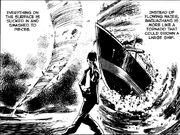| Baguazhang | |
|---|---|
[[ | |
|
High Class Disciple |
Natsu Tanimoto |
Baguazhang (八卦掌 Bàguà Zhǎng; literally meaning "eight trigram palm"), also known as the direct Japanese translation Hakke Sho, is one of the major "internal" Chinese martial arts.
Description[]
Baguazhang contains an extremely wide variety of techniques, including various strikes (with palm, fist, elbow, fingers, etc.), kicks, joint locks, throws, and distinctively evasive circular footwork. As such, Baguazhang is considered neither a purely striking nor a purely grappling martial art.
Baguazhang practitioners are known for their ability to "flow" in and out of the way of objects. Baguazhang's evasive nature is also shown by the practice of moving behind an attacker, so that the opponent cannot harm the practitioner.
The practice of circle walking, or "turning the circle", as it is sometimes called, is Baguazhang's characteristic method of stance and movement training. All forms of Baguazhang utilize circle walking prevalently as an integral part of training. Practitioners walk around the edge of the circle in various low stances, facing the center, and periodically change direction as they execute forms. For a beginner the circle is six to twelve feet in diameter. Students first learn flexibility and proper body alignment through the basic exercises, then move on to more complex forms and internal power mechanics. The Circular movements can also be applied to the user's arms, in which a master-class martial artist can control the radius of his reach with these circular techniques, allowing them to instantly block, redirect, and counter an opponent's attack, all within the time span of a single breath.
The internal aspects of Baguazhang are varied in nature, with many distinctive styles of weapons being used in tandem with it, ranging from a pair of knives, swords, and a broadsword. Other, more conventional weapons are also used, such as the staff, spears, hook swords, etc. Baguazhang practitioners are also known for being able to use anything as a weapon, using the principles of their art.
Although the many branches of Baguazhang are often quite different from each other (some, like Cheng style, specialize in close-in wrestling and joint locks, while others, like some of the Yin styles, specialize in quick, long-range striking), all have circle walking, spiraling methodologies, and certain methods and techniques (piercing palms, crashing palms, etc.) in common. Baguazhang's movements employ the whole body with smooth coiling and uncoiling actions, utilizing hand techniques, dynamic footwork, and throws. Rapid-fire movements draw energy from the center of the abdomen. The circular stepping pattern also builds up centripetal force, allowing the practitioner to maneuver quickly around an opponent.
Techniques[]
- Guo: Stopping the opponents arm as if coiling, is called Guo.
- Gun: Then deflecting it while spinning it, is called Gun.
- Zuan: Returning the arm's position while pushing, is called Zuan.
- Zheng: Pushing it even farther, is called Zheng.
- Bagua's Seiryuu Tansou: You first aims for opponent's eyes, then strike their lower body, then turns to strike them in the stomach then finishes this move with knocking opponent onto the ground.
- Bagua 72 Antai (Bagua's 72 Hidden Kicks): A series of powerful kicks.
- Bagua Tashin Kaei (Bagua Fleeing Shadow): User turns away from opponent as a feint, in order to strike opponent with their palms.
- Tangnibu: The user surrounds their opponent in all directions by moving very fast, traping their opponents in circular area.
- Kouho Haiho: This technique, also known as the stepping method, is derived from Baguazhang. When the toes comes together it is called Kouho, and when they pivot out it is called Haiho. The key to this technique is how the user moves their feet, now that the user stepped forward with the right foot they can put all their weight on it and leaves the left foot free, allowing them to pivot away to the other side of the opponent. The user leaves their upper body in place until the very last moment, and by pivoting away, the user can easily avoid their opponent's attacks. Once mastered, this technique can be used to catch their opponent's off guard and knock them to the ground before they have time to react.
- Nukiashi (Without Foot): This technique, also known as the Trackless Step combines breath control and footwork, in order to enter into an opponent's "blindspot" (殺し, Korui), making users motions far difficult to perceive until it's too late for them to avoid. Once mastered the same concept can be used on a crowd of civilians by reading their blindspots, then walk and weave through them undetected.